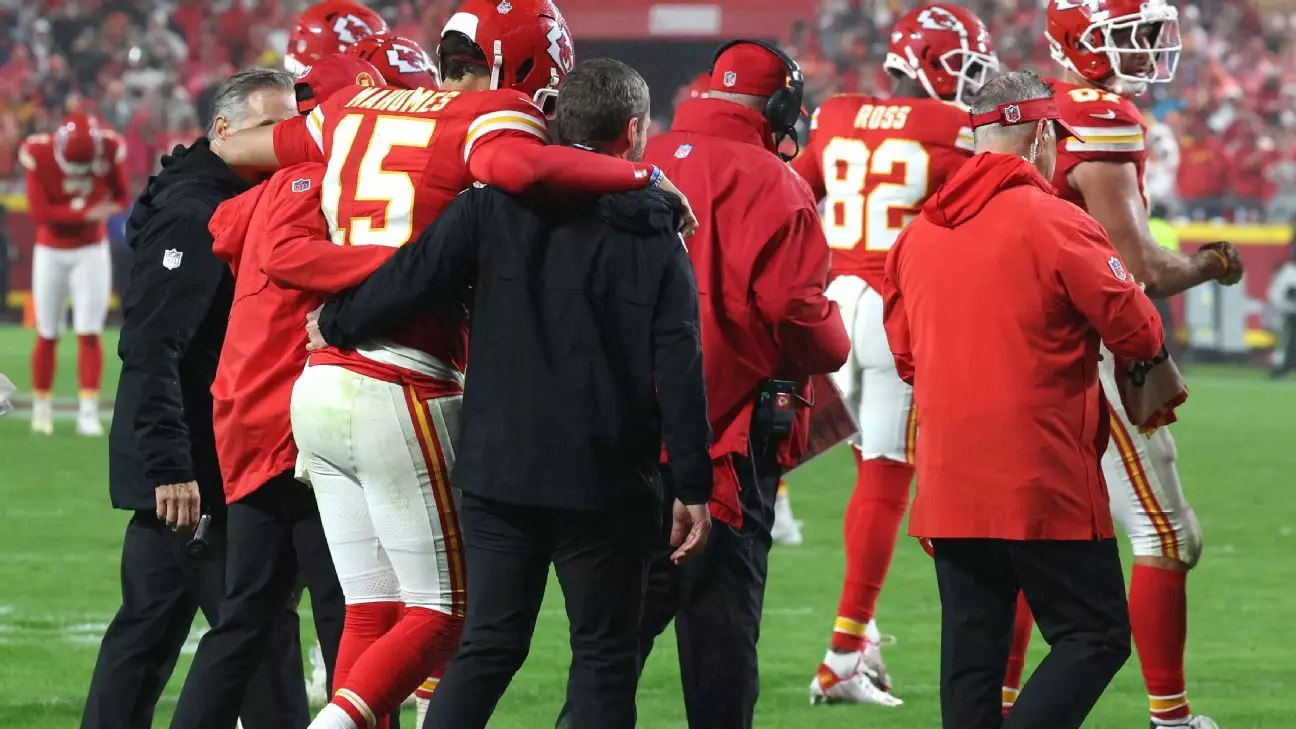In the electrifying world of the NFL, where the stakes are sky-high and every play can make or break a season, the true mettle of a player is revealed through moments of crisis. Such was the case on a recent Monday night, when Kansas City Chiefs quarterback Patrick Mahomes faced a potentially devastating injury during a nail-biting game against the Tampa Bay Buccaneers. This incident not only tested Mahomes’ physical resilience but also brought to light the intricate dynamics of player-coach relationships during high-pressure situations.
As the game progressed into the fourth quarter, Mahomes experienced a moment of sheer panic. After a difficult play, he found himself on the turf, gingerly trying to rise while nursing what he feared was another serious injury to his left ankle. The stakes were not just about winning that night’s game; they held implications for the entire season. “Definitely scary,” Mahomes reflected later, recognizing the mental toll that injury speculation can take on an athlete. The haunting memories of a similar injury the previous week only intensified his anxiety. The alarming sensation of sharp pain coursing through his ankle instantly triggered thoughts of potential long-term ramifications, leaving Mahomes—and Chiefs fans—on the edge of their seats.
Despite these fears, Mahomes showcased a remarkable ability to persevere. With the clock ticking and tensions high, he shook off the injury and went on to throw yet another touchdown pass. This pivotal moment helped the Chiefs edge past the Buccaneers with a final score of 30-24, marking an impressive 8-0 record for the season. Notably, Mahomes demonstrated not only his physical capability but also his leadership as he rallied his team in a moment of challenge.
For Chiefs head coach Andy Reid, the decision to keep Mahomes in the game was fraught with complexity. Reid, who has seen the detrimental effects of injuries on his star player in the past, was ready to make the tough call to pull Mahomes from the game. This was reminiscent of the 2022 playoffs when Reid took Mahomes out after he sustained an injury, a decision that sparked a mix of concern and frustration from Mahomes himself. Based on his unwavering competitive spirit, Mahomes was right to suspect Reid’s initial intentions were somewhat humorous. “Come on, we’re not doing this again,” Mahomes recounted, suffused with competitive spirit that defines elite athletes.
However, Reid’s deep understanding of Mahomes’ capabilities as a competitor allowed for an adjustment. After observing the quarterback’s insistence that the injury was not akin to past experiences, Reid conceded and allowed him back on the field, a testament to the mutual respect between the player and his coach, bolstered by Mahomes’ track record of overcoming adversities.
Post-game, the focus shifted to Mahomes’ recovery. He engaged in mobility tests on the sidelines and assured fans he would be ready to face the Denver Broncos the coming Sunday. Yet, Mahomes’ experience brings to the forefront a critical discussion on athlete health management. The rigors of the NFL, which often sees players sacrificing personal well-being for team victory, imply a systematic need for protocols that safeguard players while retaining competitive integrity.
Mahomes’ insight into his own healing process was refreshingly candid. He characterized the pain he felt after the recent injury as manageable relative to past experiences, hinting at a distinguishing characteristic of seasoned athletes: the understanding of their bodies’ limits and capabilities. The injury’s nature—non-contact and resulting from a split-second decision—echoed the unpredictability athletes face every game, a reminder that peril often lurks on the field during moments of high engagement.
In retrospect, the events of that game encapsulated the essence of sportsmanship intertwined with human fragility. Patrick Mahomes’ journey underlines the significance of resilience in professional sports and serves as an inspiration for athletes everywhere facing their own challenges. His story is not merely one of physical endurance but a nuanced narrative demonstrating the complex interplay between fear, leadership, and an indomitable spirit. Ultimately, in the high-octane world of professional football, it is this spirit that elevates a player from mere participant to a true legend of the game.

